
A maze is a path or collection of paths, typically from an entrance to a goal. The word is used to refer both to branching tour puzzles through which the solver must find a route, and to simpler non-branching ("unicursal") patterns that lead unambiguously through a convoluted layout to a goal. The pathways and walls in a maze are typically fixed, but puzzles in which the walls and paths can change during the game are also categorised as mazes or tour puzzles.
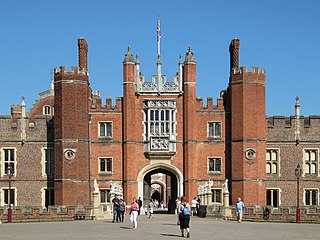
Hampton Court Palace is a Grade I listed royal palace in the London Borough of Richmond upon Thames, 12 miles south west and upstream of central London on the River Thames. The building of the palace began in 1514 for Cardinal Thomas Wolsey, the chief minister of King Henry VIII. In 1529, as Wolsey fell from favour, the cardinal gave the palace to the king to check his disgrace. The palace went on to become one of Henry's most favoured residences; soon after acquiring the property, he arranged for it to be enlarged so that it might more easily accommodate his sizeable retinue of courtiers. Along with St James' Palace, it is one of only two surviving palaces out of the many the king owned. The palace is currently in the possession of Queen Elizabeth II and the Crown.
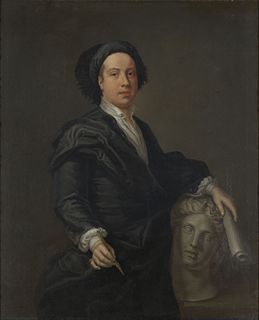
William Kent was an eminent English architect, landscape architect, painter and furniture designer of the early 18th century. He began his career as a painter, and became Principal Painter in Ordinary or court painter, but his real talent was for design in various media.
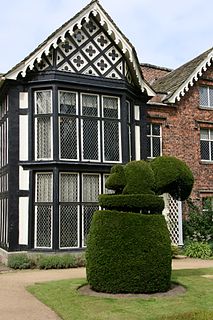
Topiary is the horticultural practice of training perennial plants by clipping the foliage and twigs of trees, shrubs and subshrubs to develop and maintain clearly defined shapes, whether geometric or fanciful. The term also refers to plants which have been shaped in this way. As an art form it is a type of living sculpture. The word derives from the Latin word for an ornamental landscape gardener, topiarius, a creator of topia or "places", a Greek word that Romans also applied to fictive indoor landscapes executed in fresco.

Bushy Park in the London Borough of Richmond upon Thames is the second largest of London's Royal Parks, at 445 hectares in area, after Richmond Park. The park, most of which is open to the public, is immediately north of Hampton Court Palace and Hampton Court Park and is a few minutes' walk from the west side of Kingston Bridge. It is surrounded by Teddington, Hampton, Hampton Hill and Hampton Wick and is mainly within the post towns of Hampton and Teddington, those of East Molesey and Kingston upon Thames taking the remainder.

A parterre is a part of a formal garden constructed on a level substrate, consisting of symmetrical patterns, made up by plant beds, low hedges or coloured gravels, which are separated and connected by paths. Typically it was the part of the garden nearest the house, perhaps after a terrace. The view of it from inside the house, especially from the upper floors, was a major consideration in its design. The word "parterre" was and is used both for the whole part of the garden containing parterres and for each individual section between the "alleys".

Castle Bromwich Hall Gardens are situated adjacent to the west side of Castle Bromwich Hall, a Jacobean Mansion. They are in the old centre of Castle Bromwich, a large village in the Metropolitan Borough of Solihull of the English West Midlands area.
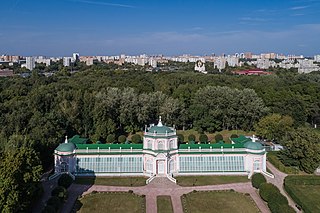
An orangery or orangerie was a room or a dedicated building on the grounds of fashionable residences from the 17th to the 19th centuries where orange and other fruit trees were protected during the winter, as a very large form of greenhouse or conservatory.

Hampton Court Park, also known as Home Park, is a walled royal park managed by the Historic Royal Palaces. The park lies between the gardens of Hampton Court Palace and Kingston upon Thames and Surbiton in south west London, England, mostly within the post town of East Molesey, but with its eastern extremity within the post town of Kingston. In 2014, part of the park was designated a biological Site of Special Scientific Interest. It takes up most of the final (lowest) meander of the non-tidal reaches of the River Thames and is mainly divided between a golf course, meadows interspersed with trees used for deer, seasonal horse grazing and wildlife. A corner of the park is used annually for the Hampton Court Flower Show and the part nearest to the palace has the Long Water — an early set of hydro-engineered ponds or lakes, fed by water from the distant River Colne, as are the bodies of water in the neighbouring park, Bushy Park.
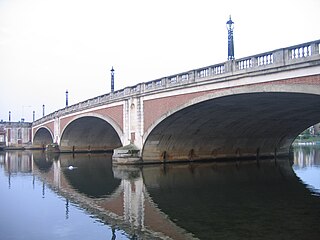
Hampton Court Bridge is a Grade II listed bridge that crosses the River Thames in England approximately north–south between Hampton, London and East Molesey, Surrey, carrying the A309. It is the upper of two road bridges on the reach above Teddington Lock and downstream of Molesey Lock.
Gilbert Randoll Coate was a British diplomat, maze designer and "labyrinthologist".

A hedge maze is an outdoor garden maze or labyrinth in which the "walls" or dividers between passages are made of vertical hedges.

Dutch garden refers firstly to gardens in the Netherlands, but also, mainly in the English-speaking countries, to various types of gardens traditionally considered to be in a Dutch style, a presumption that has been much disputed by garden historians in recent decades. Historically gardens in the Netherlands have generally followed trends from neighbouring countries, but from the Early Modern period, Dutch gardens were distinctive for the wider range of plants available over the rest of Europe north of the Alps, and an emphasis on individual specimen plants, often sparsely planted in a bed. In the 17th century and into the 18th, the Dutch dominated the publishing of botanical books, and established the very strong position in the breeding and growing of garden plants, which they still retain. They were perhaps also distinguished by their efficient use of space, and in large examples, the use of topiary and small "canals", long thin, rectangular artificial stretches of water. When a distinctively "Dutch" style is claimed, it generally relates to formal styles in large gardens in the latter part of the 17th century, stretching on for a few decades.

Capel Manor College is London’s only specialist environmental college, offering a diverse range of full and part-time courses in further and higher education for young people and adults. It is located in Enfield.

The Diana Fountain in Bushy Park, in the London Borough of Richmond upon Thames, is a seventeenth-century statue ensemble and water feature in an eighteenth-century setting with a surrounding pool and mile long tree lined vistas which honors the Roman Goddess Diana (myth)[The gold female figure is not actually the Roman goddess Diana, it depicts her honoured friend Arethusa, a water nymph, who Diana turned into a stream in order to help her avoid the advances of lesser-God, Alpheus. In Sicily, Italy, there is a larger water feature depicting this myth, where the actual source of the stream is which inspired the original myth]. Originally created for Somerset House in the 1630s, and remodelled about 1690, the fountain has stood since 1713 in Bushy Park, and now forms a large traffic island in Chestnut Avenue.

Bridge End Gardens is a group of linked ornamental gardens in Saffron Walden, Essex, England. The gardens are listed Grade II* on the Register of Parks and Gardens. They are located off Castle Street, close to the Fry Art Gallery. Features include a maze.

A formal garden is a garden with a clear structure, geometric shapes and in most cases a symmetrical layout. Its origin goes back to the gardens which are located in the desert areas of Western Asia and are protected by walls. The style of a formal garden is reflected in the Persian gardens of Iran, and the monastic gardens from the Late Middle Ages. It has found its continuation in the Italian Renaissance gardens and has culminated in the French formal gardens from the Baroque period. Through its design, the garden conveys a sense of established order and transparency to the observer.
Stud House is an early 18th-century house in the centre of Hampton Court Park near Hampton Court Palace. It is Grade II listed on the National Heritage List for England. It was traditionally the official residence of the Master of the Horse. The former stables at the house are separately listed, also at Grade II.

In the Western history of gardening, from the 16th to early 19th centuries, a wilderness was a highly artificial and formalized type of woodland, forming a section of a large garden. Though examples varied greatly, a typical English style was a number of geometrically-arranged compartments closed round by hedges, each compartment planted inside with relatively small trees. Between the compartments there were wide walkways or "alleys", usually of grass, sometimes of gravel. The wilderness provided shade in hot weather, and relative privacy. Though often said by garden writers at the time to be intended for meditation and reading, the wilderness was much used for walking, and often flirtation. There were few if any flowers, but there might be statues, and some seating, especially in garden rooms or salle vertes, clearings left empty. Some had other features, such as a garden maze.

In the history of gardening and landscaping, a canal is a relatively large piece of water that has a very regular shape, usually long, thin and rectangular. The peak period for garden canals was the 17th and 18th centuries, by the end of which less formal water features were in favour, in the style of the English landscape garden. It is distinguished from a garden pond or lake by its shape, and typically falls somewhere between the two in area. It might be wholly artificial, created by diverting and damming a stream, or based around a natural water feature which is landscaped. Usually it appears to be enclosed, though in fact water passes in and out by channels below the surface. The edges are often walled, and the water relatively shallow.




















